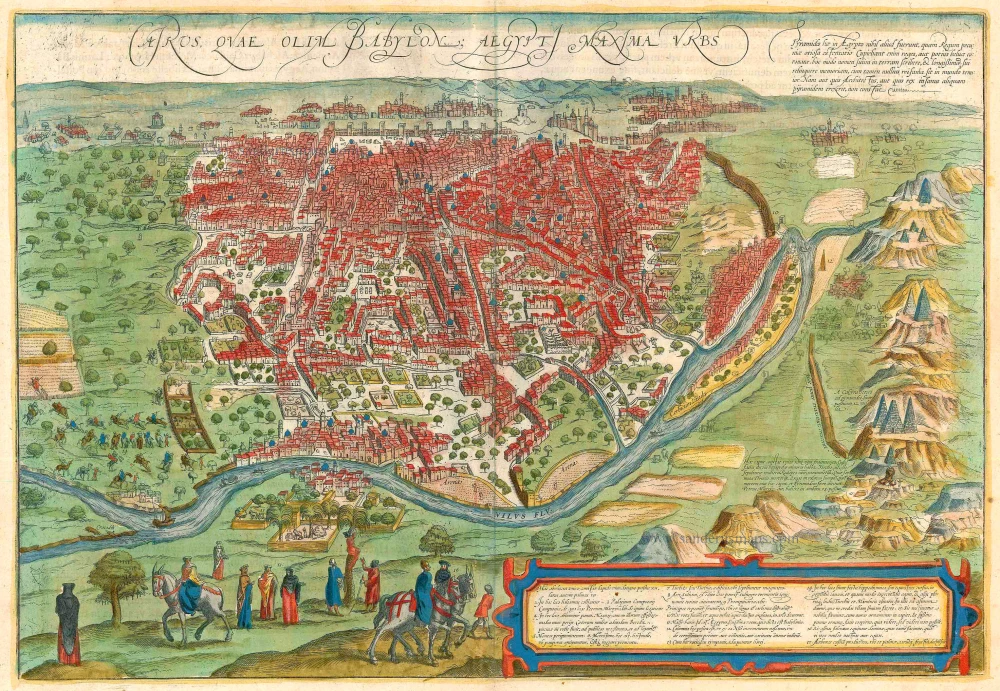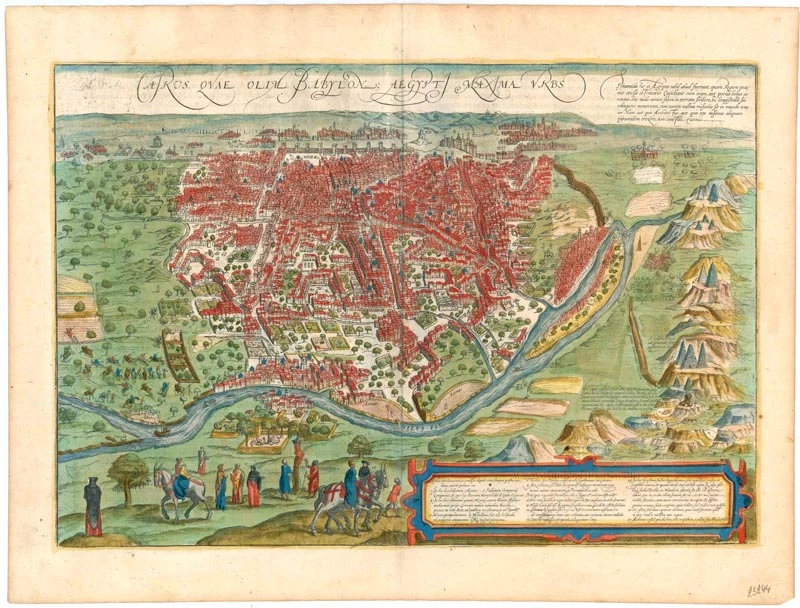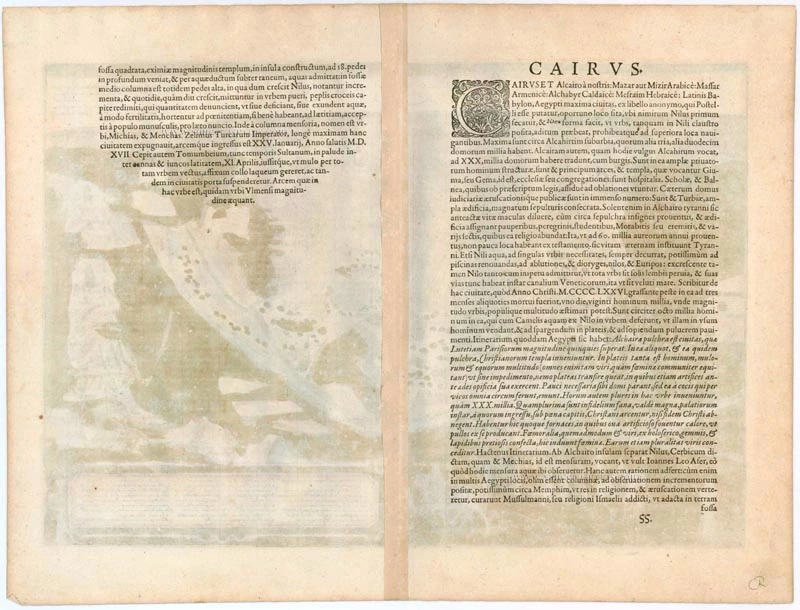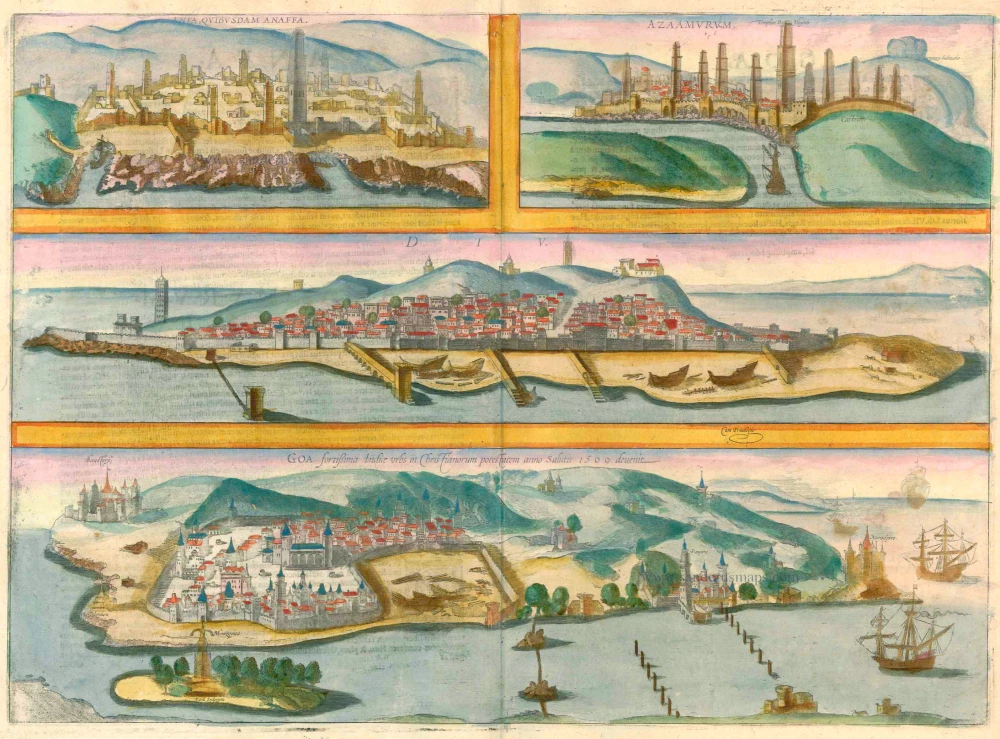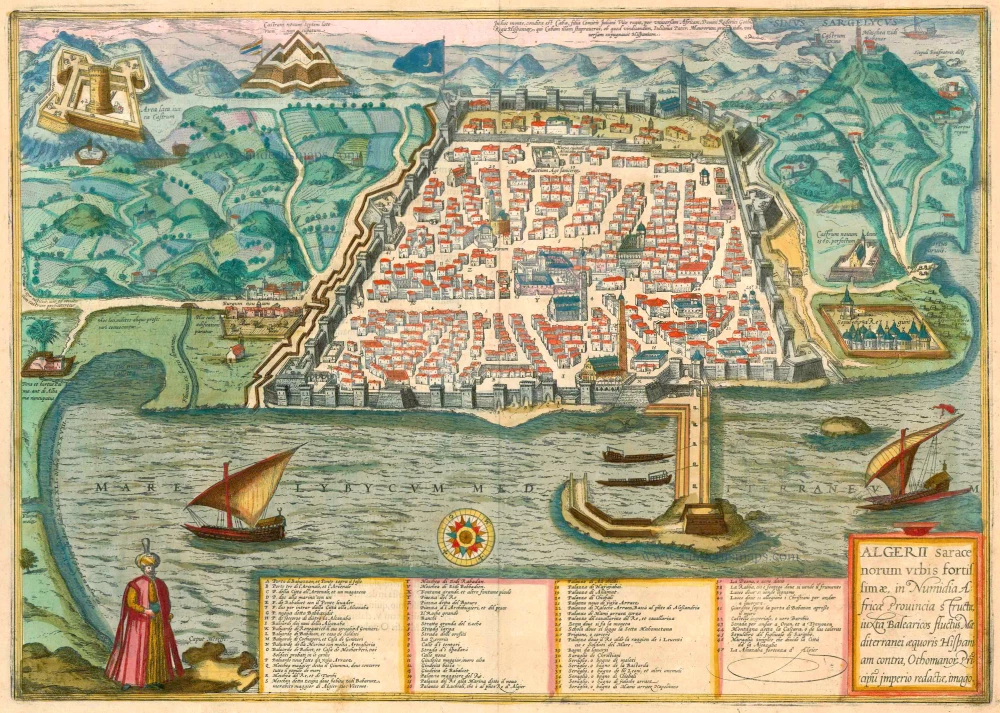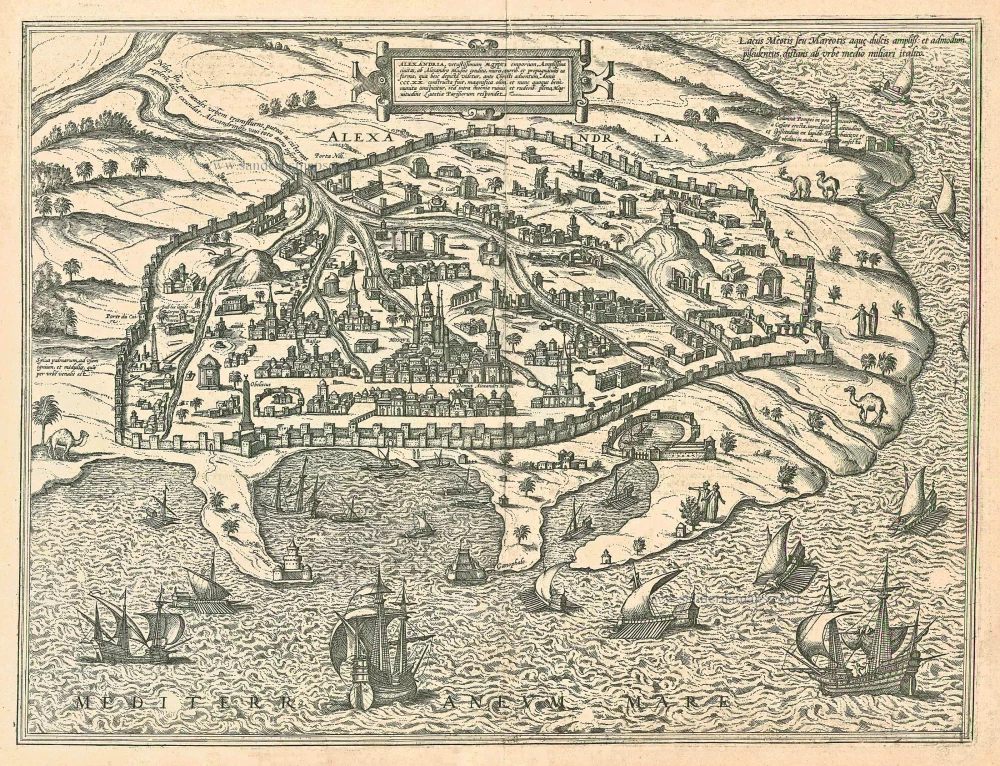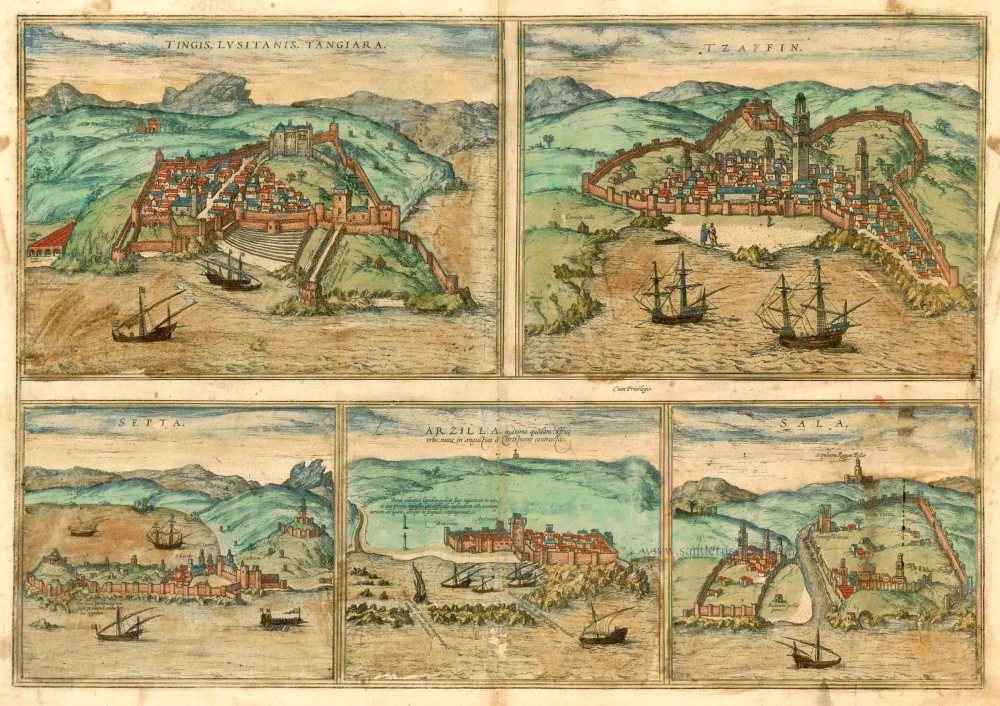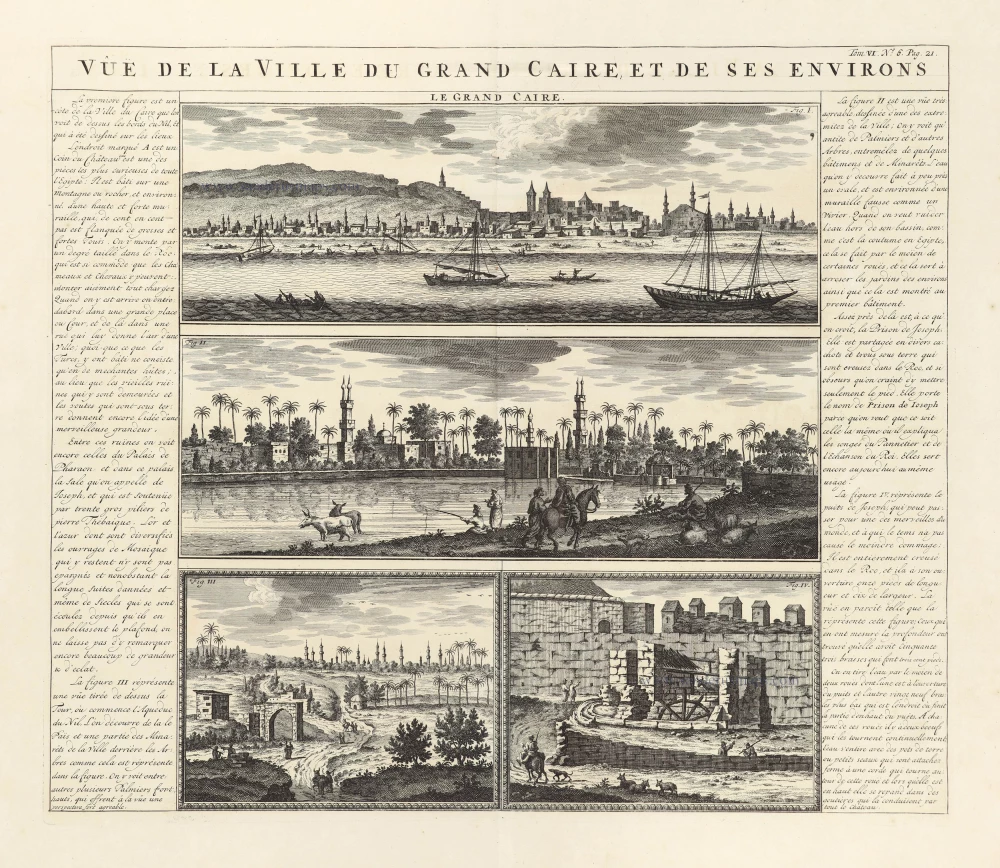Cairo, by Georg Braun and Frans Hogenberg. 1599
Translation of caption: Cairo, earlier Babylon, was a very large city in Egypt.
COMMENTARY BY BRAUN: "Cairo is said to number 30,000 houses altogether. There are many princely palaces and temples here, but also many hospices, schools and baths and large buildings containing the tombs of important persons. The streets contain such a throng of people, horses and mules that it is impossible to pass without obstacles. [...] The women, too, wear trousers made of silk, trimmed with pearls and precious gems, like the men. The men are also allowed to have several wives."
The city of Cairo, comprised of highly uniform cubic houses interspersed with minarets and gardens, is seen from the right bank of the Nile. Running down the right-hand side is a schematic range of high hills on which the pyramids and the Sphinx can be seen. The accompanying Latin text says of the Sphinx: "This head consists of a single piece of stone; the face alone is ten lesser hexapedes (a measure of length equal to six feet) long. According to Strabo, it is a monument to a beautiful, tragic hetaera named Rhodopis. The king took her as his wife, and after her death, he built this head and pyramid for her." The Latin text at the top runs: "These pyramids were nothing but an idle display of royal wealth. In this way, the kings, or rather the crowned beasts, hoped to immortalise their names on earth and keep their memory alive for a long time. However, nothing in the world is of less fame since neither the architect nor the insane king who built a pyramid is recorded." Daily life is illustrated in the left-hand foreground, where women in veils ride donkeys and a man picks dates. In 1517 Cairo became part of the Ottoman Empire and is today the capital of Egypt with some eight million inhabitants. (Taschen)
Braun G. & Hogenberg F. and the Civitates Orbis Terrarum.
The Civitates Orbis Terrarum, also known as the 'Braun & Hogenberg', is a six-volume town atlas and the most excellent book of town views and plans ever published: 363 engravings, sometimes beautifully coloured. It was one of the best-selling works in the last quarter of the 16th century. Georg Braun, a skilled writer, wrote the text accompanying the plans and views on the verso. Many plates were engraved after the original drawings of a professional artist, Joris Hoefnagel (1542-1600). The first volume was published in Latin in 1572 and the sixth in 1617. Frans Hogenberg, a talented engraver, created the tables for volumes I through IV, and Simon van den Neuwel made those for volumes V and VI. Other contributors were cartographers Daniel Freese and Heinrich Rantzau, who provided valuable geographical information. Works by Jacob van Deventer, Sebastian Münster, and Johannes Stumpf were also used as references. Translations appeared in German and French, making the atlas accessible to a wider audience.
Since its original publication of volume 1 in 1572, the Civitates Orbis Terrarum has left an indelible mark on the history of cartography. The first volume was followed by seven more editions in 1575, 1577, 1582, 1588, 1593, 1599, and 1612. Vol.2, initially released in 1575, saw subsequent editions in 1597 and 1612. The subsequent volumes, each a treasure trove of historical insights, graced the world in 1581, 1588, 1593, 1599, and 1606. The German translation of the first volume, a testament to its widespread appeal, debuted in 1574, followed by the French edition in 1575.
Several printers were involved: Theodor Graminaeus, Heinrich von Aich, Gottfried von Kempen, Johannis Sinniger, Bertram Buchholtz, and Peter von Brachel, all of whom worked in Cologne.
Georg Braun (1541-1622)
Georg Braun, the author of the text accompanying the plans and views in the Civitates Orbis Terrarum, was born in Cologne in 1541. After his studies in Cologne, he entered the Jesuit Order as a novice, indicating his commitment to learning and intellectual pursuits. In 1561, he obtained his bachelor's degree; in 1562, he received his Magister Artium, further demonstrating his academic achievements. Although he left the Jesuit Order, he continued his studies in theology, gaining a licentiate in theology. His theological background likely influenced the content and tone of the text in the Civitates Orbis Terrarum, adding a unique perspective to the work.
Frans Hogenberg (1535-1590)
Frans Hogenberg was a Flemish and German painter, engraver, and mapmaker. He was born in Mechelen as the son of Nicolaas Hogenberg.
By the end of the 1560s, Frans Hogenberg was employed upon Abraham Ortelius's Theatrum Orbis Terrarum, published in 1570; he is named an engraver of numerous maps. In 1568, he was banned from Antwerp by the Duke of Alva and travelled to London, where he stayed a few years before emigrating to Cologne. He immediately embarked on his two most important works, the Civitates, published in 1572 and the Geschichtsblätter, which appeared in several series from 1569 until about 1587.
Thanks to large-scale projects like the Geschichtsblätter and the Civitates, Hogenberg's social circumstances improved with each passing year. He died as a wealthy man in Cologne in 1590.
Cairus, quae olim Babylon; Aegypti Maxima Urbs.
Item Number: 23244 Authenticity Guarantee
Category: Antique maps > Africa
Old bird's-eye view plan of Cairo, by Georg Braun and Frans Hogenberg.
Title: Cairus, quae olim Babylon; Aegypti Maxima Urbs.
Date of the first edition: 1572.
Date of this map: 1599.
Copper engraving, printed on paper.
Size (not including margins): 330 x 490mm (12.99 x 19.29 inches).
Verso: Latin text.
Condition: Original coloured, excellent.
Condition Rating: A+.
From: Civitates Orbis Terrarum, Liber Primus. Köln, Bertram Buchholtz, 1599. (Van der Krogt 4, 41:1.1)
Translation of caption: Cairo, earlier Babylon, was a very large city in Egypt.
COMMENTARY BY BRAUN: "Cairo is said to number 30,000 houses altogether. There are many princely palaces and temples here, but also many hospices, schools and baths and large buildings containing the tombs of important persons. The streets contain such a throng of people, horses and mules that it is impossible to pass without obstacles. [...] The women, too, wear trousers made of silk, trimmed with pearls and precious gems, like the men. The men are also allowed to have several wives."
The city of Cairo, comprised of highly uniform cubic houses interspersed with minarets and gardens, is seen from the right bank of the Nile. Running down the right-hand side is a schematic range of high hills on which the pyramids and the Sphinx can be seen. The accompanying Latin text says of the Sphinx: "This head consists of a single piece of stone; the face alone is ten lesser hexapedes (a measure of length equal to six feet) long. According to Strabo, it is a monument to a beautiful, tragic hetaera named Rhodopis. The king took her as his wife, and after her death, he built this head and pyramid for her." The Latin text at the top runs: "These pyramids were nothing but an idle display of royal wealth. In this way, the kings, or rather the crowned beasts, hoped to immortalise their names on earth and keep their memory alive for a long time. However, nothing in the world is of less fame since neither the architect nor the insane king who built a pyramid is recorded." Daily life is illustrated in the left-hand foreground, where women in veils ride donkeys and a man picks dates. In 1517 Cairo became part of the Ottoman Empire and is today the capital of Egypt with some eight million inhabitants. (Taschen)
Braun G. & Hogenberg F. and the Civitates Orbis Terrarum.
The Civitates Orbis Terrarum, also known as the 'Braun & Hogenberg', is a six-volume town atlas and the most excellent book of town views and plans ever published: 363 engravings, sometimes beautifully coloured. It was one of the best-selling works in the last quarter of the 16th century. Georg Braun, a skilled writer, wrote the text accompanying the plans and views on the verso. Many plates were engraved after the original drawings of a professional artist, Joris Hoefnagel (1542-1600). The first volume was published in Latin in 1572 and the sixth in 1617. Frans Hogenberg, a talented engraver, created the tables for volumes I through IV, and Simon van den Neuwel made those for volumes V and VI. Other contributors were cartographers Daniel Freese and Heinrich Rantzau, who provided valuable geographical information. Works by Jacob van Deventer, Sebastian Münster, and Johannes Stumpf were also used as references. Translations appeared in German and French, making the atlas accessible to a wider audience.
Since its original publication of volume 1 in 1572, the Civitates Orbis Terrarum has left an indelible mark on the history of cartography. The first volume was followed by seven more editions in 1575, 1577, 1582, 1588, 1593, 1599, and 1612. Vol.2, initially released in 1575, saw subsequent editions in 1597 and 1612. The subsequent volumes, each a treasure trove of historical insights, graced the world in 1581, 1588, 1593, 1599, and 1606. The German translation of the first volume, a testament to its widespread appeal, debuted in 1574, followed by the French edition in 1575.
Several printers were involved: Theodor Graminaeus, Heinrich von Aich, Gottfried von Kempen, Johannis Sinniger, Bertram Buchholtz, and Peter von Brachel, all of whom worked in Cologne.
Georg Braun (1541-1622)
Georg Braun, the author of the text accompanying the plans and views in the Civitates Orbis Terrarum, was born in Cologne in 1541. After his studies in Cologne, he entered the Jesuit Order as a novice, indicating his commitment to learning and intellectual pursuits. In 1561, he obtained his bachelor's degree; in 1562, he received his Magister Artium, further demonstrating his academic achievements. Although he left the Jesuit Order, he continued his studies in theology, gaining a licentiate in theology. His theological background likely influenced the content and tone of the text in the Civitates Orbis Terrarum, adding a unique perspective to the work.
Frans Hogenberg (1535-1590)
Frans Hogenberg was a Flemish and German painter, engraver, and mapmaker. He was born in Mechelen as the son of Nicolaas Hogenberg.
By the end of the 1560s, Frans Hogenberg was employed upon Abraham Ortelius's Theatrum Orbis Terrarum, published in 1570; he is named an engraver of numerous maps. In 1568, he was banned from Antwerp by the Duke of Alva and travelled to London, where he stayed a few years before emigrating to Cologne. He immediately embarked on his two most important works, the Civitates, published in 1572 and the Geschichtsblätter, which appeared in several series from 1569 until about 1587.
Thanks to large-scale projects like the Geschichtsblätter and the Civitates, Hogenberg's social circumstances improved with each passing year. He died as a wealthy man in Cologne in 1590.

